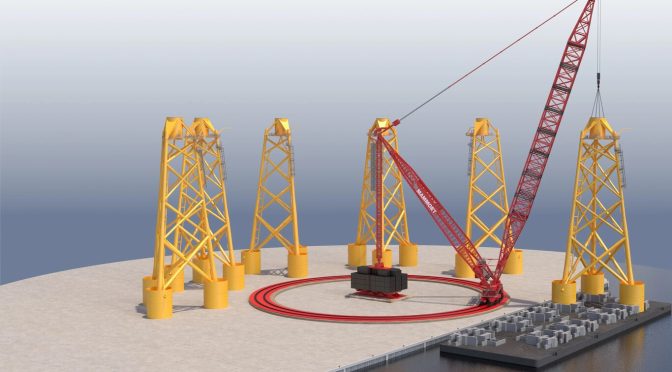If we want large offshore wind farms spread along the coast or on the high seas, it will not come to us by manufacturing huge turbines, record-breaking blades or XXL supports. We need to move them. And that, when we are talking about gigantic pieces that weigh tons, is easier said than done. At Mammoet, a Dutch company specialized in lifting and transporting large structures, they have made a similar reasoning and that is why they have decided to strengthen their muscle. As? Equipped with SK6000, which is already claimed as the largest electric crane.
What is SK6000? The largest electric crane in the world. Or so it is presented by Mammoet, a historic company based in Ultrecht and specialized in the logistics of heavy objects. Once completed, SK6000 will be a ring crane, a design characterized by its luffing jib and a circular track that allows it to rotate while moving loads with considerable weight. And what is considerable falls short, given the data that Mammoet handles. SK6000 is designed to operate with electric power and provide a load capacity of 6,000 tons.
They are not its only peculiarities. The SK6000 crane will be transported in containers to facilitate its movement and assembly. When designing it, its creators have also taken advantage of part of the strengths of its predecessor, the SK350. “It shares the same engineering DNA. Much of the crane technology has been operating successfully and safely on projects around the world for many years,” says the firm.
What features does it have? In addition to its load capacity, electrical operation and design, with a ring-shaped pivot, the SK6000 stands out for its dimensions. The main mast reaches 171 meters in length, although it can be extended up to 274 in elevation if an accessory is added. As a reference, the Eiffel Tower measures 330 m with antenna.
“It enables modular construction on a larger scale than ever before, reducing the number of operations, crane reconfigurations and working at height during heavy industrial projects. Like other cranes in the SK range, it reduces hassle and preparation on site thanks to to a centralized ballast design that only requires a section of its ring depending on the needs of each project,” he adds.
What calendar do you run? One that aims for the short term. The company has announced that its engineering powerhouse in the Netherlands will receive the first parts of the SK6000 “shortly” and that the production phase will progress over the next few months as it prepares for its first project, with delivery expected. already by 2024. Mammoet emphasizes that it is not starting from scratch: the SK6000 builds on the design proven with the SK190 and SK350 designs.
Because it is important? For that very reason: the opportunities it offers. “With the innovation of the SK6000 crane, our customers can think bigger than ever, taking the modules beyond the barriers of 4,000 tons and even 5,000”, says Mammoet, who even goes further, already pointing to “a new standard in heavy lifting capacity.”
“It allows you to build larger and heavier components,” he stresses. The objective: to break the limitations that engineers may now be encountering when manufacturing the modules due to the difficulties in moving them, handicaps that end up complicating the projects: “The SK6000 allows you to build bigger than ever, offering a maximum lifting capacity up to 6,000 t”.
And the offshore wind? It is one of the great beneficiaries mentioned by Mammoet, which ensures that the crane has been designed taking into account the new offshore parks. “As offshore wind components grow in scale and weight, greater lifting capacity is needed. SK6000 delivers that capacity and unlocks an important design constraint. Our latest innovation will enable customers to integrate taller and larger turbines and launch heavier foundations.” , either fixed or floating”, it abounds.
The goal: to facilitate reaching deeper waters, while also significantly cutting assembly costs. A key advantage considering that companies have begun to design larger mills with an eye toward locations far from the coast, where they can benefit from strong gusts of wind. “As the industry moves towards 20 MW turbines, floating wind components continue to grow in size and weight.” And all, of course, using cranes that use electrical energy during the construction phase itself.
by Ruetir


